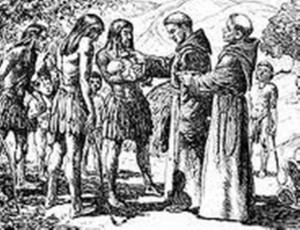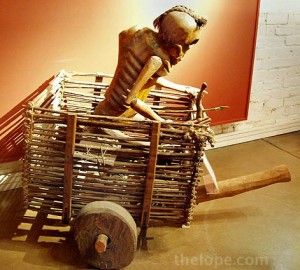While Frederick R. Barnard coined the phrase “a picture is worth a thousand words,” it was mostly likely Aby Warbury whose ideas lead to the creation of that phrase. After moving to Italy to learn about art, Aby Warbury (a German boy) quickly realized that art was more than just an image for aesthetic appeal. Rather, art was created to illustrate the memories of past societies. In other words, Warbury believed that art represents a window into past societies.
In a presentation given by Italian anthropologist, Carlos Severi, I learned about the affects that the arrival of the Spanish had on the indigenous people in New Mexico. Not only did the Spaniards impose their social and political systems, they slowly forced the native people to convert to Catholicism. Franciscan priests lived in the indigenous villages, teaching the natives about Spanish Catholicism. Over time, these native people began to forget their own religion and started to accept this new religion. However, by 1828, the Franciscan clergy left these villages and returned to Spain—leaving the indigenous people with a new religion that they didn’t fully understand and an old religion that they had forgotten.
Without priests to guide them, the indigenous people started to piece together a new religion: a mixture of Spanish Christianity and their old religion. This new religion, now known as the Penitente Brotherhood, was much darker than Christianity and focused on death rather than on redemption and light. Sacrifice, flagellation, and reenactments of Jesus crucifixion were all elements of Penitente Brotherhood. However, at the forefront of this new religion was Dona Sebastiana, the angel of death. Donna Sebastiana is usually depicted as a skeleton with long brown hair riding in a cart carrying arrows. Every year, she would ‘shoot’ one villager with an arrow, which meant that that villager was chosen to give up his life for his religion (in other words, he would become a martyr). It is believed that Dona Sebastiana is derived from the Christian Saint, St. Sebastian who died after being shot by arrows. This shows how the indigenous people were attempting to recreate the religion left by the Franciscans; however, because the Franciscans left before the indigenous people had fully understood and knew the religion, these dark modifications arose from the piecing together of the two religions.
This dark, death orientated religion arose only after the Franciscans left the Native Americans to make sense of an unfamiliar religion. Without guidance, these people pieced together what they remembered from their native religion and what they had been taught by the Spanish. While the rituals and figures of this religion are hard to understand, the context of the time period and the events leading up to development of the religion help us see into the memory of the indigenous people of the time. This idea, then, goes hand in hand with Aby Warburg beliefs on art. By analyzing and contextualizing images like Dona Sebastiana, we have a picture of what these indigenous societies were like back in the 1800s. Images of Dona Sebastiana act as a window into the thoughts and beliefs of the indigenous people.
References:
Image 1: http://www.cherylannestapp.com/colonizing-california/
Image 2: http://www.thelope.com/2006/04/death-cart.html
Extra Reading: http://www.thelope.com/2006/04/death-cart.html


